Résumé Parsing
What is résumé parsing?
Résumé parsing (or CV parsing) is the automated process of extracting relevant information from résumé and converting it into a structured format. This technology uses algorithms or artificial intelligence to analyze résumés and identify key details such as:
- Personal information: Name, contact details, address.
- Work experience: Job titles, employers, dates of employment, responsibilities.
- Education: Degrees, schools attended, graduation dates.
- Skills: Both hard and soft skills, certifications, or proficiencies.
- Other details: Languages spoken, professional summaries, or objective statements.
Often integrated into Applicant Tracking Systems (ATS), résumé parsing saves recruiters time and effort by automating the identification of qualified candidates. It streamlines the hiring process by extracting and organizing data like contact details, work history, and job-related keywords, making recruitment faster and more efficient.
How does résumé parsing work?
In the technical aspect, résumé parsing software carries out several steps for extracting desired data from résumés. These steps typically include:
- Data extraction: Since applicants submit résumés in various formats (e.g., Word or PDF), parsing tools must first scan and convert each one to an editable text document, using Optical Character Recognition (OCR) to transform pixels into digital text.
- Text processing: Next, parsing algorithms analyze the text file, using natural language processing (NLP) to look for specific data patterns. The software then makes human language-based decisions according to custom commands, including analyzing grammar and extracting names, dates, and other information.
- Data structuring: Finally, the algorithms “learn” what data sets to identify and extract before sorting and organizing them into relevant categories in standardized XML or JSON formats, which are imported into ATS or HRIS. Recruiters can search for candidates with keywords while the system groups résumés into job requisition folders.

Résumé parsing software
Here are some popular résumé parsing software options to consider:
HireEZ
Formerly called Hiretual, HireEZ is an AI-powered talent intelligence suite that offers résumé parsing and recruitment CRM capabilities. Easy to integrate with many ATS solutions, it can enhance candidate matching with filtering features. Recruiters can search for, screen, and connect with candidates on an intuitive dashboard.
Textkernel (Bullhorn)
Textkernel is an AI-powered recruitment platform with a résumé and CV parser integrated with HR systems. The parser automatically extracts data and provides analytical tools to simplify recruitment processes and enhance HR’s use of this information. The platform offers résumé parsing in 29 languages.
Zoho Recruit
Zoho Recruit is a cloud-based ATS and recruitment CRM with a built-in résumé parser that can extract detailed information from résumés and CVs while creating candidate profiles. This makes it easier for recruiters to locate skilled candidates.
Workable
Workable is an AI-powered ATS and employee management system that matches the best talent with job requisitions. Its résumé parser extracts and anonymizes details from résumés for unbiased recruitment processes.
Greenhouse
Greenhouse is a complete ATS and candidate management system that features several résumé parsing tools that automate the candidate screening process. They can also integrate with HRIS and other employee management solutions.
Optimize your recruitment process with effective résumé parsing
To streamline the recruitment process with effective résumé parsing, you must define key hiring criteria, choose a reliable parsing tool, and integrate it with your ATS.
In AIHR’s Sourcing and Recruitment Certificate Program, you’ll learn to create targeted candidate personas and job descriptions to help refine the résumé parsing process.
This online, self-paced Certificate Program will also teach you how to master talent sourcing methods and search techniques to source and engage talent even for the most difficult-to-fill positions.
Résumé parsing benefits
Résumé parsing technology’s primary benefit is the ability to automate candidate screening, but there are other benefits to consider. These include:
- Better candidate-job matching: Résumé parsing tools use AI-enabled systems to match candidates to open jobs, which improves recruiters’ ability to target the most qualified candidates.
- Decreased time to hire: Résumé and CV parsing can save recruiters time by automating the initial screening process of new applicants. This frees up recruiters to focus on interacting with candidates, shortening the time to hire.
- Enhanced data accuracy and security: Résumé parsing software is designed to extract key data and organize it within a secure ATS. This leads to improved accuracy, which helps reduce mistakes and inconsistencies in the recruitment workflow.
- Data-driven decision-making: Résumé parsing helps break down data based on job-specific requirements, which can reduce bias in hiring decisions. This data can also help measure the success of recruitment programs and improve future hiring efforts.
Résumé parsing challenges
While résumé parsing software is useful, it can also pose certain challenges. These include:
- Keyword limitations: Parsing résumés focuses on specific keywords and phrases. This means a qualified candidate whose résumé lacks the desired keywords may be overlooked or rejected. For example, a candidate with “data science” experience on their résumé may be screened out if the preferred keyword is “information analysis.”
- Non-standard résumé formats: Résumé parsing software may encounter problems with extracting accurate data from non-standard documents. This can happen with résumés that include images or graphics, hyperlinks, or other non-text elements.
- Ambiguous language: Industry jargon, cultural language differences, and ambiguous content can hamper NLP, meaning there’s always the potential to misinterpret information.
- Candidate frustration: If the parser fails to process their résumé correctly, candidates may need to re-enter data manually, which can cause frustration and potentially discourage them from applying.
6 tips for effective résumé parsing
Here are some practical tips to help HR teams make the most of résumé parsing tools:
- Choose the right parsing tool: Select a résumé parsing tool that integrates seamlessly with your applicant tracking system (ATS) and supports the formats most commonly used by applicants, like PDFs, Word documents, and plain text files.
- Optimize job descriptions: Ensure job descriptions are clear and include relevant keywords for skills, qualifications, and experience. This ensures the parsing system accurately matches résumés to job requirements.
- Train the parsing system: If your tool allows for customization, train it to recognize industry-specific jargon, certifications, and uncommon job titles to improve parsing accuracy.
- Validate parsed data: Cross-check parsed résumés occasionally to identify errors or missed details. This can help refine the parsing system’s accuracy and ensure important candidate information isn’t overlooked.
- Use filters and tags: Set up filters and tags for key criteria, such as years of experience, certifications, or location preferences. This ensures the system focuses on the most relevant applications.
- Combine with human oversight: While résumé parsing tools are effective, recruiters should be involved in reviewing shortlisted applications for nuanced aspects like cultural fit and soft skills.
HR tip
When creating a job advertisement, include relevant keywords and phrases that match the skills, qualifications, and job titles for the role. This helps résumé parsing software identify qualified candidates and ensures your ad attracts top talent. Use precise, industry-specific terms and align your language with common job descriptions to improve ATS compatibility.









